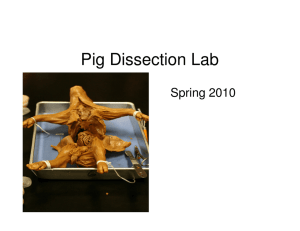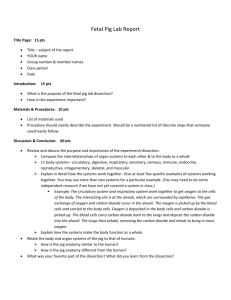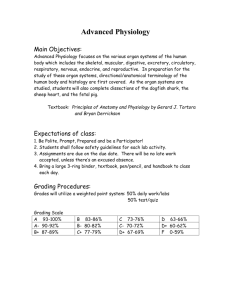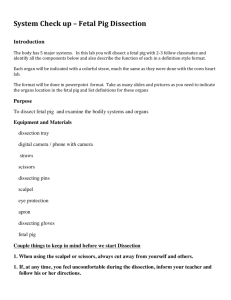AP Biology Fetal Pig Dissection Lab
advertisement
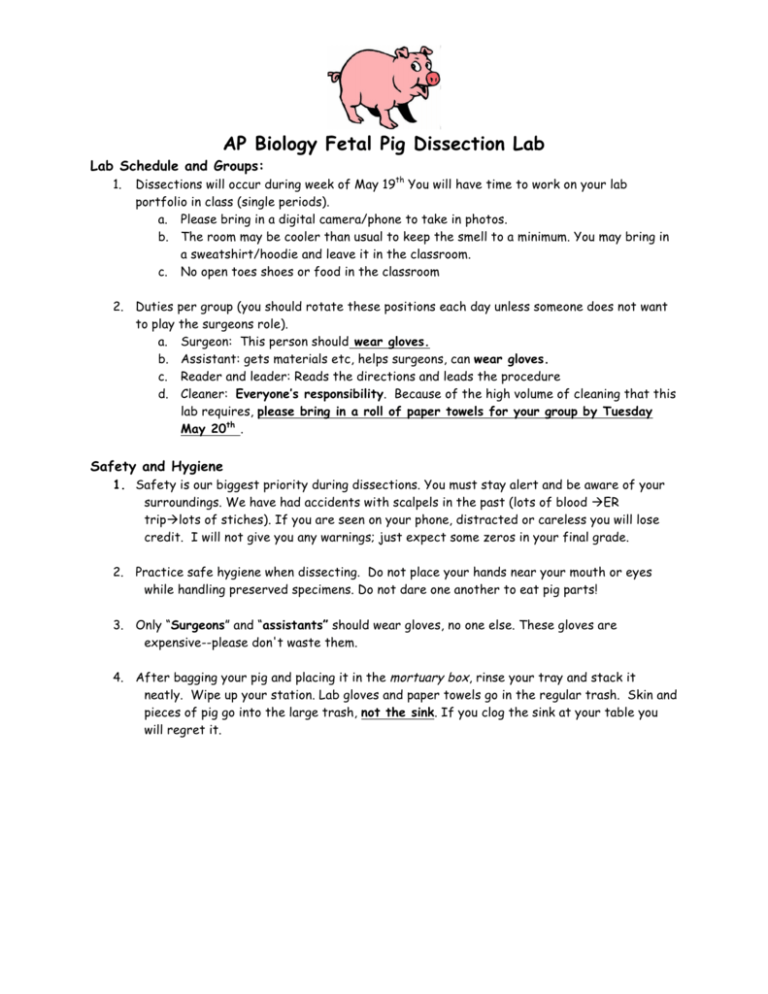
AP Biology Fetal Pig Dissection Lab Lab Schedule and Groups: 1. Dissections will occur during week of May 19th You will have time to work on your lab portfolio in class (single periods). a. Please bring in a digital camera/phone to take in photos. b. The room may be cooler than usual to keep the smell to a minimum. You may bring in a sweatshirt/hoodie and leave it in the classroom. c. No open toes shoes or food in the classroom 2. Duties per group (you should rotate these positions each day unless someone does not want to play the surgeons role). a. Surgeon: This person should wear gloves. b. Assistant: gets materials etc, helps surgeons, can wear gloves. c. Reader and leader: Reads the directions and leads the procedure d. Cleaner: Everyone’s responsibility. Because of the high volume of cleaning that this lab requires, please bring in a roll of paper towels for your group by Tuesday May 20th . Safety and Hygiene 1. Safety is our biggest priority during dissections. You must stay alert and be aware of your surroundings. We have had accidents with scalpels in the past (lots of blood àER tripàlots of stiches). If you are seen on your phone, distracted or careless you will lose credit. I will not give you any warnings; just expect some zeros in your final grade. 2. Practice safe hygiene when dissecting. Do not place your hands near your mouth or eyes while handling preserved specimens. Do not dare one another to eat pig parts! 3. Only “Surgeons” and “assistants” should wear gloves, no one else. These gloves are expensive--please don't waste them. 4. After bagging your pig and placing it in the mortuary box, rinse your tray and stack it neatly. Wipe up your station. Lab gloves and paper towels go in the regular trash. Skin and pieces of pig go into the large trash, not the sink. If you clog the sink at your table you will regret it. AP Biology Fetal Pig Dissection Project You must dissection and observe the entire fetal pig for you practicum, however for your project you will only have to focus on an assigned system. You will create a portfolio to demonstrate your knowledge of one assigned body system (digestive, cardiovascular, urogenital). You portfolio must include the following: 1. Procedure/Daily Journal • Include a record of what was done each day. This should be at least one paragraph /day. Include observations of the anatomical parts that were dissected/measured. You should use proper anatomy terms to describe what was cut and how it was cut (medial, lateral etc). • Make sure you use “we” and not “I” in your report. • Include interesting observations and any challenges you had on a particular day 2. Assigned System (Digestive/Cardiovascular/Urogenital** • For your assigned system include: o Name of the organs o Functions of the organs o Secretions (enzymes/hormones etc), their functions/roles o Neurological link (How does your system tied to the nervous system?) o **Urogenital groups need to include both male and female anatomy 3. Photographs • Include the following general photographs in your portfolio: o External Pig Anatomy o Gender Identification o Tools and materials used for dissection • Include at least 5-8 pictures of organs in your assigned system o Photographs can include several organs at one time o Structures in each photograph should be labeled o Major organs/structures should also be measured (metric) (include the #’s in a key for the image or directly on photo) o You need to identify a minimum of _20_ structures 4. Pig vs. Human Comparison • Compare your assigned system in the pig (can be adults not fetal) to the same system in the human body. • Use photographs and pictures to illustrate points • Compare organs in both organisms Pig Practicum Terms This list is the summary of terms that you should know for your test. There is no word bank on the test. Please visit the Whitman Virtual Pig Dissection web site for a review. allantoic duct anatomical vocab aorta apex bile duct carotid artery common bile duct coronary artery diaphragm elbow epiglottis external iliac female pig femoral vein forceps gall bladder hard palate heart heel hepatic duct internal iliac kidney knee large intestine larynx left ventricle liver lungs male pig mesentery neck nictitating membrane pancreas peritoneum pinna pleura probe pulmonary artery renal artery renal artery renal vein renal vein right atrium right ventricle septum small intestine small intestine parts soft palate soft palate sphinters spinal cord spleen stomach subclavian artery subscapular artery teats thymus thyroid tongue trunk umbilical artery umbilical cord umbilical vein vibrissae wrist


